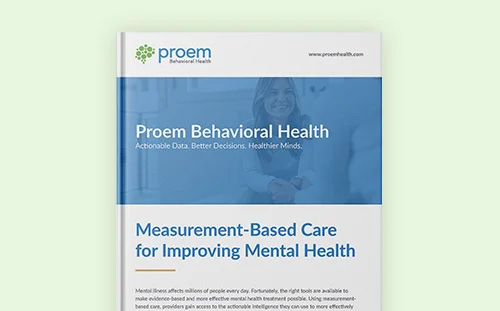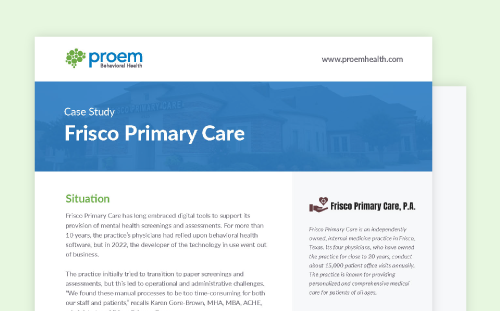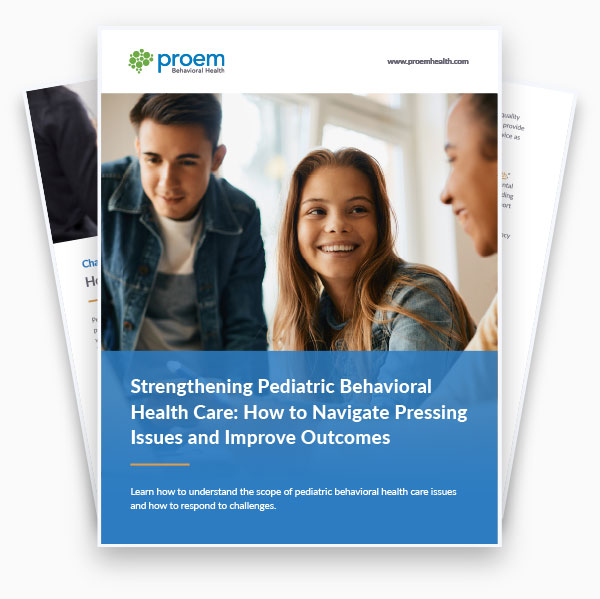Strengthening Pediatric Behavioral Health Care: How to Navigate Pressing Issues and Improve Outcomes
Amid a national conversation about mental health care, one key group has been largely left out. Today's children and adolescents face mental health challenges unlike any their parents and grandparents knew at similar ages, and many young people don't get the help and support they need.
Though the problem is serious, there is a path to better outcomes for this highly at-risk population. Thanks to technological advancements, behavioral health care providers can access digital screening, assessment and treatment tools that help them make more informed clinical decisions which reduce barriers to care and improve treatment for those who suffer from mental illness.
Digital tools can make mental health less intimidating and more user-friendly for today's connected youth. But to make the best possible use of these tools, providers must understand how they help to address barriers to successful care. Read on to gain a better understanding of the pediatric mental health crisis and how to best meet and overcome its challenges.

Chapter 1:
The Current State of Pediatric Mental Health
The COVID-19 pandemic has been a popular scapegoat for worsening mental health among children and teens. While it is a significant contributing factor, it is not the sole cause. The pediatric mental health crisis existed long before the novel coronavirus became a global threat.
What the pandemic has done, however, is expand the national conversation about mental health and wellness. This discussion has further encouraged mental health professionals and those who work with children to look more closely at the drivers of pediatric mental illness.
What Is Fueling the Current Pediatric Mental Health Crisis?
Childhood and adolescence have always been sensitive periods for mental health, with experiences during these periods having the potential to significantly affect lifetime behavioral health. Almost half of mental disorders emerge by age 18, with the peak onset age being 14.5 years. This raises a question: Why are healthcare providers now seeing so many more children in crisis?
-
Isolationism has a significant impact on mental illness in youth.
Research shows a "strong association between social isolation and anxiety and depression in children and adolescents," and the COVID-19 pandemic isolated children from friends, extended family, teachers and other important individuals in their lives on a massive scale. Schools closed and activities shut down, forcing young people indoors and severely limiting crucial in-person interactions.
-
Children are strained by an increasing awareness of world stressors.
Due to today's always-on news cycle and notification culture, children and adolescents are increasingly aware of world issues. Children often lack the coping mechanisms to process this exposure to conflict, disaster and injustice. They may feel afraid, angry or numb and become overwhelmed by what they see and hear.
-
Immediate stressors at school are increasing the youth mental health crisis.
Today's children also face more extreme school stressors. The past 10 years have brought a dramatic increase in the number of shootings at K–12 schools, sparking fears of violence among children and the adults in their lives.
Schools have also become ethical battlegrounds, placing youth in the middle of divisive debates. Even children's private lives have become more stressful as smartphone and social media use increases vulnerability to bullying, social comparison and body image issues.
-
Many children lack access to pediatric behavioral health services.
Despite being increasingly vulnerable to stressors, children and adolescents often lack access to adequate mental health services. Many families live in areas with a shortage of providers, requiring parents to travel long distances with their children or spend extended periods on waiting lists. Financial barriers also exist, given that the out-of-pocket cost of therapy typically ranges from $100 to $200 per hour.
Role of Adverse Childhood Experiences in Pediatric Behavioral Health
Adverse childhood experiences (ACEs) can significantly increase a child's vulnerability to mental illness. ACEs affect brain development and may contribute to emotional and behavioral challenges. ACEs are potentially traumatic experiences occurring before age 18. These experiences threaten a child's physical, social and psychological safety and stability. Examples include:
-
Poverty
-
Bullying
-
Physical, sexual or emotional abuse or neglect
-
Mental illness, violence or incarceration in the home
Across multiple studies, children with one adverse childhood experience have been highly likely to report at least one other ACE.
Importance of Addressing ACEs in Pediatric Populations
Recent data suggests that approximately one in three U.S. children have experienced at least one ACE. Providers may mitigate adverse outcomes associated with adverse childhood experiences by identifying these ACEs and offering appropriate interventions.
ACEs affect children’s brain development.
Children's brains need emotional stability and responsive caregivers to grow. Abuse and neglect stagnate brain development and may limit the growth of critical regions, including the amygdala, hippocampus and prefrontal cortex. Children with such deficits may struggle with behavioral and emotional regulation, learning and memory, and resilience to stress. In one study, severe household stressors increased children's risk of developmental delay or mental health disorders by up to 250%.
Severe household stressors can cause up to a
increase in children’s risk of mental health disorders
ACEs can predict negative outcomes.
Since the affected brain regions play critical roles in cognitive and emotional processing, ACEs increase the likelihood a child will struggle in those areas. Warning signs may include:
-
Cognitive delays
-
School adjustment and achievement problems
-
Attention and behavior regulation issues
-
Attention deficit hyperactivity disorder (ADHD)
-
Reduced emotion and behavior regulation capacity
-
Difficulty forming or maintaining healthy relationships
These issues occur due to a chronic stress response in the brain. Excessive stress in childhood, possibly exacerbated by a lack of parental soothing, interrupts the brain's learning how to self-soothe. Stress becomes chronic and overwhelms the mind's ability to adapt.
In response to a lack of self-soothing capacity, children with ACEs may engage in dangerous behaviors, like substance use and unprotected sex. Such behaviors can increase a child's vulnerability to physical harm and long-term social consequences.
How Pediatricians Can Better Support Children's Behavioral Health
Pediatricians have the unique opportunity to partner with families in supporting children's mental health. Office visits are the ideal opportunity to inquire about a child's emotional and behavioral health and identify common warning signs, such as anxiety, low mood, disruptive behavior and learning difficulties. Telehealth can make these conversations easier than ever, both in screening and follow-up.
Given a trusting relationship, such conversations can also provide sounding boards for concerned parents unsure whether their child's struggles are "normal" or a sign of a possible mental health problem. Pediatricians should screen for ACEs and social risks, including food security and family function.
Pediatricians Can Play a Larger Role in Children's Behavioral Health
Pediatricians have always been front-line providers and children's caregivers. As the mental health crisis deepens and specialists find themselves with packed caseloads, pediatricians are the last or only resource for many desperate families.
Unfortunately, pediatricians also face a persistent gap in mental health training. The American Academy of Pediatrics has acknowledged the need for additional education in mental health competencies, but such systemic change takes time to implement. Meanwhile, it falls to the practicing physician to seek information and training opportunities.

Chapter 2:
How Pediatric and Adult Behavioral Health Differs
Pediatric behavioral care follows a different pattern than adult care, which typically begins with the patient's choice to seek support. Therefore, pediatric behavioral health does not — and cannot — look like adult care.
How Pediatric Behavioral Health Support Differs From Adult Support
Children usually lack the self-awareness and knowledge to navigate the help-seeking process independently, especially in pre-adolescence. They more often show their need for help via behavioral or mood changes. If the child is fortunate, a caring adult will notice a potential problem and start the help-seeking process.
The caregiver-dependent model of care poses several problems. First, it is unrealistic to expect caregivers and educators to identify mental illness warning signs consistently. Even if the adult is sufficiently attuned to the children in their care, symptoms may present differently in children. For example, pediatric depression may present with anger and irritability rather than sadness and low mood, which is often associated with adult depression.
To close the identification gap, providers need evidence-based mental health screening tools that are patient-friendly and integrate easily into clinical workflows. Available tools — such as the Mini International Neuropsychiatric Interview (M.I.N.I.), which is available in screener and assessment versions written for children and adolescents ages 6-8, 9-12 and 13-17 — support pediatric practices in implementing universal mental health screenings.
Pediatric behavioral health must consider child development.
The developing child's mind responds to experiences differently than an adult's. A child who has experienced a stressful or traumatic experience may not have the tools to describe, understand or process their feelings. Some children may dissociate or "shut down," while others become hypervigilant and prone to intense emotional reactions. In all cases, trauma can permanently affect how the child navigates the world.
To be effective, clinicians must work with children in an appropriate manner for their developmental stage, such as with less reflective talk therapy and more behavioral or relational strategies. Play therapy, parent-child interaction therapy and cognitive behavior therapy are common approaches.
Improving pediatric behavioral health should involve parents or caregivers when appropriate.
Adult involvement is essential in pediatric behavioral health. Just as children need parents and caregivers to help them understand and follow a physician's instructions, they need assistance applying the skills they learn in therapy.
"You can't just take a child into a room, do psychotherapy, and think, 'Well, that's going to work when they go back out into the world,' because they're not in charge of themselves."
Genevieve Daftary, MD,
Clinician
Source: HealthCity
Research has shown that dyadic care models involving the adult and child are three times as effective as a child-only treatment. The parent provides essential scaffolding to help the child understand the treatment process and practice skills learned in the session.
What to Know About Using Pediatric Assessment Tools
Developmentally appropriate care starts with screening and assessment. Ideally, healthcare providers would have the resources to screen all pediatric patients for mental health issues, following up on any red flags so no one falls through the cracks.
Initial screenings must be quick, accurate, economical and easily administered. Some pediatric screeners that fit this description include:
-
The Pediatric Symptom Checklist, a 17-question evaluation for children four to 17 years old
-
Mini International Neuropsychiatric Interview (M.I.N.I.) KID, a 15- to 30-minute interview with age-appropriate language for children and adolescents ages 6-8, 9-12 and 13-17
-
The Kid Mood Disorder Screener, a 9-point questionnaire for ages 13 to 17
By standardizing the evaluation process, these screeners identify more symptoms of mental illness and reduce the chances of a missed or inaccurate diagnosis.
As the Pediatric Mental Health Institute of Children's Hospital Colorado has noted, "Pediatric practices often under-detect mental health issues in children, particularly when medical providers rely on clinical judgment or poorly constructed screening measures ... Pediatric providers who rely solely on clinical judgment to identify patients with mental health concerns will only positively identify approximately 30% of clinical patients, whereas 70% of these patients are accurately identified when using a validated screening measure."
of pediatric patients with mental health concerns are accurately identified when using a validated screening measure
These numbers indicate that with quality assessment tools, pediatricians can provide accurate diagnoses for more than twice as many children.
The U.S. Surgeon General's advisory report, "Protecting Youth Mental Health," recommends routine screening for "mental health challenges and risk factors, including adverse childhood experiences." The report indicates such screenings can happen in various community settings, including primary care offices, schools, and emergency departments.
Reliable and convenient assessment tools, such as the Adverse Childhood Experiences (ACEs) screener and Pediatric ACEs and Related Life Events Screener (PEARLS), allow providers to implement these recommendations for all patients.

Chapter 3:
Challenges and Opportunities in Pediatric Behavioral Health
Caregivers have historically lacked the resources to distinguish warning signs, such as mood swings and distractibility, from childhood's "normal" challenges. Additionally, adults who notice red flags often face the additional barrier of not knowing where or how to seek help, even when services are available.
School systems and medical practices can play a vital role in raising awareness, educating families on the characteristics of typical behavior versus a potential concern. To be effective, these systems must commit to connecting all families in need with quality care.
Overcoming Barriers to Managing Children's Mental Health Services
Disorders in children have not traditionally received as much attention as disorders in adults. This can be attributed to some extent to the difficulty in identifying behaviors that may be a natural part of growing up (e.g., being easily distracted, being subject to mood swings) and parents (or guardians) not knowing when to seek help. Let’s examine some other barriers and ways to overcome them.
-
Most children don’t get screened for anxiety and depression.
Given the barriers to accessing or even being aware of children's mental health services, it's not surprising that pediatric anxiety and depression screening has been lacking. This gap leaves children vulnerable to missed diagnoses, especially in cases where symptoms are less apparent.
New and renewed recommendations may change that pattern. In early 2022, the U.S. Preventive Services Task Force (USPSTF) reaffirmed its guidance to screen adolescents aged 12 to 18 for depression and added in a new request to screen youth aged 8 to 18 for anxiety. -
There aren’t as many assessment tools designed for children’s mental health services.
Pediatric healthcare providers have a narrower selection of mental health tools to choose from and incorporate into their care delivery, despite children needing age-appropriate assessment instruments. Fortunately, as awareness of the pediatric mental health crisis grows, more targeted tools have entered development and clinical use. The Mini International Neuropsychiatric Interview (M.I.N.I.) KID, for example, is a screener and diagnostic interview written using language that is understood by children and adolescents based on their age.
-
Primary care providers lack critical information concerning pediatric behavioral health.
Primary care providers are often the first to see a child with mental health concerns, but they face significant barriers in offering adequate help. In addition to gaps in training, pediatricians have competing demands on their time and often don't have anywhere to point families in need. Sufficient assessment resources are essential to making screening more time-efficient effective and suggesting next steps when mental illness is identified.
-
Access and cost barriers often prevent mental health care for children.
Behavioral health care is often logistically and financially inaccessible. Mental Health America data shows that about 8% of U.S. children lack insurance coverage for mental or emotional needs. Some states have double or more that percentage. For children in low-income households, a lack of coverage represents a significant barrier to care.
8%of U.S. children who have private insurance lack insurance coverage for mental or emotional needs
Data indicates that expanding coverage can reduce the overall cost of care, as can expanded use of telehealth. Virtual visits can help primary care and pediatric mental health care providers make services more accessible.
-
Some demographics have not historically accessed care.
Clinically appropriate treatment and support systems available online may also improve access to care for children from historically under-resourced communities. According to a study published in Psychiatric Services, children in poverty face numerous logistical barriers to care, most notably a lack of proximity to services and changes in parent employment.
Unfortunately, children with these barriers often have a higher-than-typical need for services due to community violence, housing instability and food insecurity. Access to online therapies and family case management can help connect these children with support, assuming providers have adequate resources for screening and appropriate referral to specialists.
Ways to Strengthen Children's Behavioral Therapy
-
Improve mental health care training and competence for pediatricians.
Improving mental health competencies at the point of care is a national priority for the American Academy of Pediatrics (AAP). A 2019 AAP policy statement calls for expanded integration of those competencies into pediatric practice, beginning with more focused professional education.
AAP supports enhanced training in mental health screening and evaluation, patient education, and essential psychosocial and psychopharmacologic treatment. The goals are a more integrated pediatric practice model that destigmatizes mental illness, connects families with resources and develops partnerships with skilled specialists.
-
Establish integrated care models in pediatric practice.
Local specialists are one of primary care provider's best behavioral health resources. There are two primary ways to establish partnerships with such specialists:
Collaborative Care Model
The American Psychiatric Association recommends the collaborative care model for patient-centric care. This model improves behavioral health access by integrating it into the primary care setting. The primary care provider works with a behavioral health manager to develop a treatment plan, drawing on the expertise of a psychiatric consultant as needed.
The collaborative care model eases the burden on overbooked psychiatric practitioners and supports pediatricians who want to help but lack the time and expertise to provide complete treatment. It also allows primary care pediatricians and mental health specialists to share skills, subject matter knowledge and an understanding of each patient's needs.
Other Integrated Care Models
A collaborative care model may not be possible or practical for all settings. When an alternative is necessary, co-located care can partially integrate services. A shared location allows for regular contact, resource sharing and mutual skill-building between providers, even without caseload sharing.
Some states also provide physicians with a child psychiatry access program (CPAP). Initially developed in Massachusetts, the CPAP system provides psychiatric phone consultations to primary care providers. Such consultations are essential in the absence of qualified local practitioners. -
Advocate for mental health funding and policies in school systems.
Outside the immediate family, school personnel are in the best possible position to observe children's mental health needs. Teachers and aides often have the outside perspective and knowledge to identify disorders early but need intervention resources.
Statistics support the value of making mental health services available in school. Students who receive these services have better academic and social outcomes, including more positive perceptions of school. Additionally, adolescents are more likely to receive mental health services in the school setting, suggesting that school-based services are essential to access.
To provide such services, schools need:
-
Instructional staff trained in mental health support
-
Community, family and legislative partnerships
-
Ongoing needs assessment with referral to quality services
Many schools would like to provide this support but are unable to do so. Among schools that report barriers, 48% cite funding as an issue, and 57% note a lack of provider access. The National Center for School Mental Health offers a funding and sustainability quality guide in response to these needs. -

Chapter 4:
The Role of Digital Tools in Pediatric Behavioral Health
Technology is vital in reaching today's youth. According to Pew Research, 97% of teenagers use the internet daily and nearly half are online "almost constantly." Approximately 95% have smartphone access, and 90% can easily access a laptop or desktop. By harnessing the power of digital therapies, providers can significantly expand behavioral health's reach.
3 Ways Digital Tools Improve Behavioral Health for Children
Digital tools have the potential to revolutionize end-to-end pediatric behavioral health. Online screening and care can improve accessibility for multiple populations, including families who struggle with scheduling and transportation. Digital instruments can also offer a higher level of appeal for children and teens accustomed to online interactions.
-
Digital tools offer entry points for clinical care.
Digital solutions support effective behavioral health for children, including those who may be unable or hesitant to request support face-to-face. Expert-designed and age-appropriate solutions offer immediate assistance for help-seeking young people while providing a framework for provider-initiated screening. When these assessments are easy to access and incorporate into existing workflows, providers can identify more children with mental illnesses and risk factors.
-
Digital tools help close the treatment gap.
Many youth experience barriers to mental health care. For example, more than 10% of US children experience depression severe enough to impair daily functioning, yet nearly 60% receive no treatment. Only 28% receive acceptably consistent care.
Digital tools allow providers to make care more accessible, whether barriers are logistical or emotional. These tools bring skilled mental health care to youth facing transportation challenges or living in remote areas while offering options to those who prefer virtual visits. In a 2020 survey, 41% of Generation Z clients preferred virtual care — a higher ratio than any other age group.
41%of Generation Z clients preferred virtual care
Digital tools also provide discrete solutions to youth with emotional and social barriers to care. Those barriers may include mental illness stigma, concerns about parents' finances or fears of seeming overly dependent. Similarly, digital tools provide crucial connection opportunities for youth who don't feel safe involving their parents or caregivers directly in psychiatric care.
-
Digital tools monitor recovery for improved outcomes.
Providers need resources to monitor patients' behavioral health progress to achieve lasting results. Monitoring is critical when treating children, given their developmental needs and reliance on adult help.
Results monitoring tools may be similar in format to essential screening tools presented to the child or parent during a follow-up appointment. Researchers are also working on advanced behavior analysis technology using smartphone data to assess patterns and identify warning signs. This automated approach offers significant benefits for young patients less able to self-assess.
The Role of Tech in the Modern Pediatrics Behavioral Health Practice
Technology has already begun to transform behavioral health care for children and adolescents. Removing obstacles and decreasing resistance make treatment more approachable and accessible on multiple levels. Today's digital natives turn to online spaces for connection, support and peer acceptance.
"For many children with anxiety, their [mobile] device is an escape, their happy place. If counselors can engage with them in this psychologically safe place, then half the battle has been won."
Helen Spiers
Head of Counseling at Mable Therapy
Source: Medtech News
Video Interactions as a 'Safe Space'
Most adolescents already use video chat to have meaningful conversations with close friends. As Spiers notes, such comfort with video chatting may be part of why online counseling has less stigma among younger clients. This level of social acceptance and familiarity with the format encourages participation in teens and pre-teens.
Increased Agency
Digital platforms help many young people to feel more in control of their therapeutic experience. Unlike in an adult-controlled physical space such as a therapist's office, an online therapy session or assessment can occur in the child's or teen's environment. They can disengage if things get too overwhelming, and that agency helps them to engage more easily.
Healing Through Digital Therapeutics
Digital therapeutic tools, including app-based and gamified interventions, have enormous potential for enhancing the mental health care of young digital natives. According to a 2020 editorial in the Journal of Child Psychology and Psychiatry, these tools can "go beyond simply replicating traditional face-to-face interventions online by providing interventions that are more effective, more accessible and more cost-effective." Such interventions, including app-based and gamified treatment aids, are widely accessible and feel familiar to the 95% of teenagers who use smartphones.
Still, digital therapeutics are largely unregulated and not always developmentally appropriate for young clients. Providers need to know about these apps — not only to recommend them as appropriate but understand what youth might discover independently, both beneficial and potentially harmful.
Closing the Accessibility Gap in Behavioral Health Pediatrics
Technology can circumvent the many barriers to care, from extended provider waitlists to the cost of specialist assessments. Digital tools allow more families to connect with providers, often without the delays of in-person treatment.
Improving Diagnosis and Intervention Rates
Although close to two-thirds of mental illnesses emerge before age 25, it takes an average of 11 years to diagnose individual issues correctly. Technology-powered universal screening can identify more warning signs and symptoms, possibly shortening the time to diagnosis for many children and adolescents. In addition, some screening tools like the Mini International Neuropsychiatric Interview (M.I.N.I.) KID and the Children’s Yale-Brown Obsessive Compulsive Index (CYBOCS) are written specifically for children and adolescents, helping pediatric care providers make a more accurate diagnosis more quickly.
Increasing Screening Rates
Technology can turn mental health assessments into a routine part of the care workflow. Some of today's digital screening tools are designed to integrate easily into patient intake or check-in workflows. Healthcare providers, social services organizations and even schools can implement these solutions and reach more children who need help.
Improving the Usefulness of Results
Unlike conventional screening handouts, which patients often complete on paper, online child mental health assessments make data more readily available. Providers can see results in the context of the child's full profile rather than in isolation.
This full picture supports better and timelier diagnoses. It may also reduce the risk of misdiagnoses, especially in commonly misattributed issues such as attention deficit hyperactivity disorder and early onset bipolar disorder. By diagnosing correctly at earlier stages in a child’s life, clinicians can recommend more appropriate treatments and improve each patient's long-term outlook.
Strengthen Pediatric Behavioral Health Care Delivery with Proem's Solution
For expanded screening, assessment and treatment to become a reality, pediatric mental health tools must be validated and user-friendly. Proem meets these needs with evidence-based licensed digital assessment tools for children and adolescents ages six through 17 and parent assessment tools that help provide a clearer picture of a patient’s mental health.
These tools include and go beyond standard depression and anxiety screenings. Providers can also access in-depth licensed digital assessment tools and outcome trackers. In combination, these instruments help clinicians to optimize care plans as needed. All instruments are digital and integrate smoothly into existing workflows for provider efficiency.

Learn More At Proem Today
Is your organization looking to strengthen how you support the behavioral health needs of your patients? Contact Proem today. You’ll learn about our licensed digital behavioral health questionnaires, screening solutions, structured diagnostic interviews, severity measurement scales and post-diagnosis monitors to assess patient outcomes. They are part of Proem’s evidence-based behavioral health workflow engine that uses evidence-based measurements and proprietary algorithms to simplify the complex process of delivering mental health care. Proem is a sophisticated, yet simple way for providers to get the behavioral health data they need to make more informed clinical decisions that produce better outcomes for their patients who suffer from mental illness.









